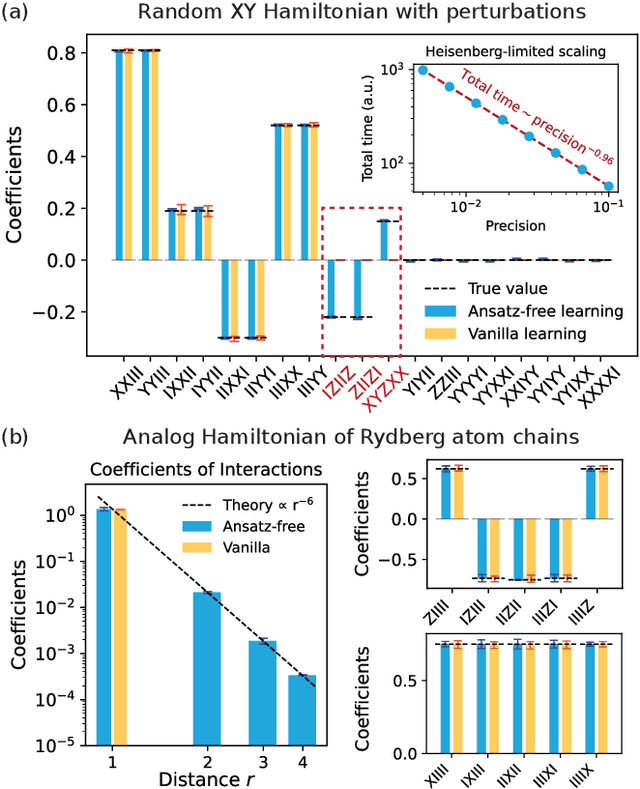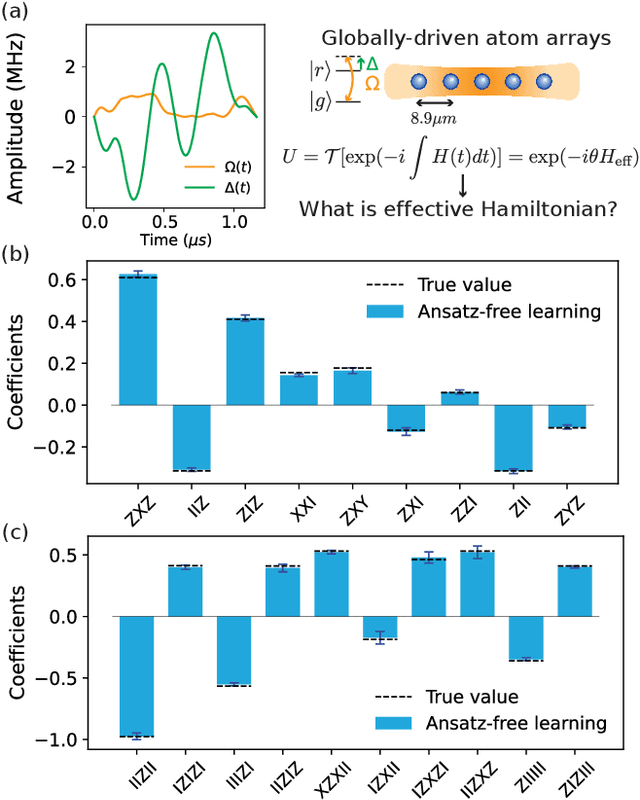Qi Ye
Orientation Learning and Adaptation towards Simultaneous Incorporation of Multiple Local Constraints
Oct 09, 2025Abstract:Orientation learning plays a pivotal role in many tasks. However, the rotation group SO(3) is a Riemannian manifold. As a result, the distortion caused by non-Euclidean geometric nature introduces difficulties to the incorporation of local constraints, especially for the simultaneous incorporation of multiple local constraints. To address this issue, we propose the Angle-Axis Space-based orientation representation method to solve several orientation learning problems, including orientation adaptation and minimization of angular acceleration. Specifically, we propose a weighted average mechanism in SO(3) based on the angle-axis representation method. Our main idea is to generate multiple trajectories by considering different local constraints at different basepoints. Then these multiple trajectories are fused to generate a smooth trajectory by our proposed weighted average mechanism, achieving the goal to incorporate multiple local constraints simultaneously. Compared with existing solution, ours can address the distortion issue and make the off-theshelf Euclidean learning algorithm be re-applicable in non-Euclidean space. Simulation and Experimental evaluations validate that our solution can not only adapt orientations towards arbitrary desired via-points and cope with angular acceleration constraints, but also incorporate multiple local constraints simultaneously to achieve extra benefits, e.g., achieving smaller acceleration costs.
STARec: An Efficient Agent Framework for Recommender Systems via Autonomous Deliberate Reasoning
Aug 26, 2025Abstract:While modern recommender systems are instrumental in navigating information abundance, they remain fundamentally limited by static user modeling and reactive decision-making paradigms. Current large language model (LLM)-based agents inherit these shortcomings through their overreliance on heuristic pattern matching, yielding recommendations prone to shallow correlation bias, limited causal inference, and brittleness in sparse-data scenarios. We introduce STARec, a slow-thinking augmented agent framework that endows recommender systems with autonomous deliberative reasoning capabilities. Each user is modeled as an agent with parallel cognitions: fast response for immediate interactions and slow reasoning that performs chain-of-thought rationales. To cultivate intrinsic slow thinking, we develop anchored reinforcement training - a two-stage paradigm combining structured knowledge distillation from advanced reasoning models with preference-aligned reward shaping. This hybrid approach scaffolds agents in acquiring foundational capabilities (preference summarization, rationale generation) while enabling dynamic policy adaptation through simulated feedback loops. Experiments on MovieLens 1M and Amazon CDs benchmarks demonstrate that STARec achieves substantial performance gains compared with state-of-the-art baselines, despite using only 0.4% of the full training data.
The Developments and Challenges towards Dexterous and Embodied Robotic Manipulation: A Survey
Jul 16, 2025Abstract:Achieving human-like dexterous robotic manipulation remains a central goal and a pivotal challenge in robotics. The development of Artificial Intelligence (AI) has allowed rapid progress in robotic manipulation. This survey summarizes the evolution of robotic manipulation from mechanical programming to embodied intelligence, alongside the transition from simple grippers to multi-fingered dexterous hands, outlining key characteristics and main challenges. Focusing on the current stage of embodied dexterous manipulation, we highlight recent advances in two critical areas: dexterous manipulation data collection (via simulation, human demonstrations, and teleoperation) and skill-learning frameworks (imitation and reinforcement learning). Then, based on the overview of the existing data collection paradigm and learning framework, three key challenges restricting the development of dexterous robotic manipulation are summarized and discussed.
MinosEval: Distinguishing Factoid and Non-Factoid for Tailored Open-Ended QA Evaluation with LLMs
Jun 18, 2025Abstract:Open-ended question answering (QA) is a key task for evaluating the capabilities of large language models (LLMs). Compared to closed-ended QA, it demands longer answer statements, more nuanced reasoning processes, and diverse expressions, making refined and interpretable automatic evaluation both crucial and challenging. Traditional metrics like ROUGE and BERTScore struggle to capture semantic similarities due to different patterns between model responses and reference answers. Current LLM-based evaluation approaches, such as pairwise or listwise comparisons of candidate answers, lack intuitive interpretability. While pointwise scoring of each response provides some descriptions, it fails to adapt across different question contents. Most notably, existing methods overlook the distinction between factoid and non-factoid questions. To address these challenges, we propose \textbf{MinosEval}, a novel evaluation method that first distinguishes open-ended questions and then ranks candidate answers using different evaluation strategies. For factoid questions, it applies an adaptive key-point scoring strategy, while for non-factoid questions, it uses an instance-aware listwise ranking strategy. Experiments on multiple open-ended QA datasets, including self-built ones with more candidate responses to complement community resources, show that MinosEval better aligns with human annotations and offers more interpretable results.
OpenHOI: Open-World Hand-Object Interaction Synthesis with Multimodal Large Language Model
May 25, 2025Abstract:Understanding and synthesizing realistic 3D hand-object interactions (HOI) is critical for applications ranging from immersive AR/VR to dexterous robotics. Existing methods struggle with generalization, performing well on closed-set objects and predefined tasks but failing to handle unseen objects or open-vocabulary instructions. We introduce OpenHOI, the first framework for open-world HOI synthesis, capable of generating long-horizon manipulation sequences for novel objects guided by free-form language commands. Our approach integrates a 3D Multimodal Large Language Model (MLLM) fine-tuned for joint affordance grounding and semantic task decomposition, enabling precise localization of interaction regions (e.g., handles, buttons) and breakdown of complex instructions (e.g., "Find a water bottle and take a sip") into executable sub-tasks. To synthesize physically plausible interactions, we propose an affordance-driven diffusion model paired with a training-free physics refinement stage that minimizes penetration and optimizes affordance alignment. Evaluations across diverse scenarios demonstrate OpenHOI's superiority over state-of-the-art methods in generalizing to novel object categories, multi-stage tasks, and complex language instructions. Our project page at \href{https://openhoi.github.io}
Neuro-Symbolic Query Compiler
May 17, 2025Abstract:Precise recognition of search intent in Retrieval-Augmented Generation (RAG) systems remains a challenging goal, especially under resource constraints and for complex queries with nested structures and dependencies. This paper presents QCompiler, a neuro-symbolic framework inspired by linguistic grammar rules and compiler design, to bridge this gap. It theoretically designs a minimal yet sufficient Backus-Naur Form (BNF) grammar $G[q]$ to formalize complex queries. Unlike previous methods, this grammar maintains completeness while minimizing redundancy. Based on this, QCompiler includes a Query Expression Translator, a Lexical Syntax Parser, and a Recursive Descent Processor to compile queries into Abstract Syntax Trees (ASTs) for execution. The atomicity of the sub-queries in the leaf nodes ensures more precise document retrieval and response generation, significantly improving the RAG system's ability to address complex queries.
Hierarchical Document Refinement for Long-context Retrieval-augmented Generation
May 15, 2025Abstract:Real-world RAG applications often encounter long-context input scenarios, where redundant information and noise results in higher inference costs and reduced performance. To address these challenges, we propose LongRefiner, an efficient plug-and-play refiner that leverages the inherent structural characteristics of long documents. LongRefiner employs dual-level query analysis, hierarchical document structuring, and adaptive refinement through multi-task learning on a single foundation model. Experiments on seven QA datasets demonstrate that LongRefiner achieves competitive performance in various scenarios while using 10x fewer computational costs and latency compared to the best baseline. Further analysis validates that LongRefiner is scalable, efficient, and effective, providing practical insights for real-world long-text RAG applications. Our code is available at https://github.com/ignorejjj/LongRefiner.
Ansatz-free Hamiltonian learning with Heisenberg-limited scaling
Feb 17, 2025



Abstract:Learning the unknown interactions that govern a quantum system is crucial for quantum information processing, device benchmarking, and quantum sensing. The problem, known as Hamiltonian learning, is well understood under the assumption that interactions are local, but this assumption may not hold for arbitrary Hamiltonians. Previous methods all require high-order inverse polynomial dependency with precision, unable to surpass the standard quantum limit and reach the gold standard Heisenberg-limited scaling. Whether Heisenberg-limited Hamiltonian learning is possible without prior assumptions about the interaction structures, a challenge we term \emph{ansatz-free Hamiltonian learning}, remains an open question. In this work, we present a quantum algorithm to learn arbitrary sparse Hamiltonians without any structure constraints using only black-box queries of the system's real-time evolution and minimal digital controls to attain Heisenberg-limited scaling in estimation error. Our method is also resilient to state-preparation-and-measurement errors, enhancing its practical feasibility. Moreover, we establish a fundamental trade-off between total evolution time and quantum control on learning arbitrary interactions, revealing the intrinsic interplay between controllability and total evolution time complexity for any learning algorithm. These results pave the way for further exploration into Heisenberg-limited Hamiltonian learning in complex quantum systems under minimal assumptions, potentially enabling new benchmarking and verification protocols.
CMQCIC-Bench: A Chinese Benchmark for Evaluating Large Language Models in Medical Quality Control Indicator Calculation
Feb 17, 2025Abstract:Medical quality control indicators are essential to assess the qualifications of healthcare institutions for medical services. With the impressive performance of large language models (LLMs) like GPT-4 in the medical field, leveraging these technologies for the Medical Quality Control Indicator Calculation (MQCIC) presents a promising approach. In this work, (1) we introduce a real-world task MQCIC and propose an open-source Chinese electronic medical records (EMRs)-based dataset (CMQCIC-Bench) comprising 785 instances and 76 indicators. (2) We propose a semi-automatic method to enhance the rule representation. Then we propose the Clinical Facts-based Inferential Rule (CF-IR) method that disentangles the clinical fact verification and inferential rule reasoning actions. (3) We conduct comprehensive experiments on 20 representative LLMs, covering general and medical models. Our findings reveal that CF-IR outperforms Chain-of-Thought methods in MQCIC tasks. (4) We conduct an error analysis and investigate the capabilities of clinical fact verification and inferential rule reasoning, providing insights to improve performance in the MQCIC further. The dataset and code is available in this repo https://anonymous.4open.science/r/C-MQCIC-1151.
Quantum automated learning with provable and explainable trainability
Feb 07, 2025

Abstract:Machine learning is widely believed to be one of the most promising practical applications of quantum computing. Existing quantum machine learning schemes typically employ a quantum-classical hybrid approach that relies crucially on gradients of model parameters. Such an approach lacks provable convergence to global minima and will become infeasible as quantum learning models scale up. Here, we introduce quantum automated learning, where no variational parameter is involved and the training process is converted to quantum state preparation. In particular, we encode training data into unitary operations and iteratively evolve a random initial state under these unitaries and their inverses, with a target-oriented perturbation towards higher prediction accuracy sandwiched in between. Under reasonable assumptions, we rigorously prove that the evolution converges exponentially to the desired state corresponding to the global minimum of the loss function. We show that such a training process can be understood from the perspective of preparing quantum states by imaginary time evolution, where the data-encoded unitaries together with target-oriented perturbations would train the quantum learning model in an automated fashion. We further prove that the quantum automated learning paradigm features good generalization ability with the generalization error upper bounded by the ratio between a logarithmic function of the Hilbert space dimension and the number of training samples. In addition, we carry out extensive numerical simulations on real-life images and quantum data to demonstrate the effectiveness of our approach and validate the assumptions. Our results establish an unconventional quantum learning strategy that is gradient-free with provable and explainable trainability, which would be crucial for large-scale practical applications of quantum computing in machine learning scenarios.
 Add to Chrome
Add to Chrome Add to Firefox
Add to Firefox Add to Edge
Add to Edge